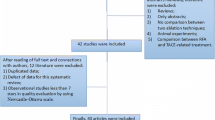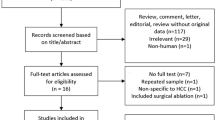Abstract
Background
Hepatocellular carcinoma (HCC) is a primary tumor of the liver with poor prognosis. For early stage HCC, treatment options include surgical resection, liver transplantation, and percutaneous ablation. Percutaneous ablative techniques (radiofrequency and microwave techniques) emerged as best therapeutic options for nonsurgical patients.
Aims
We aimed to determine the safety and efficacy of radiofrequency and microwave procedures for ablation of early stage HCC lesions and prospectively follow up our patients for survival analysis.
Patients and methods
One Hundred and 11 patients with early HCC are managed in our multidisciplinary clinic using either radiofrequency or microwave ablation. Patients are assessed for efficacy and safety. Complete ablation rate, local recurrence, and overall survival analysis are compared between both procedures.
Results
Radiofrequency ablation group (n = 45) and microwave ablation group (n = 66) were nearly comparable as regards the tumor and patients characteristics. Complete ablation was achieved in 94.2 and 96.1 % of patients managed by radiofrequency and microwave ablation techniques, respectively (p value 0.6) with a low rate of minor complications (11.1 and 3.2, respectively) including subcapsular hematoma, thigh burn, abdominal wall skin burn, and pleural effusion. Ablation rates did not differ between ablated lesions ≤3 and 3–5 cm. A lower incidence of local recurrence was observed in microwave group (3.9 vs. 13.5 % in radiofrequency group, p value 0.04). No difference between both groups as regards de novo lesions, portal vein thrombosis, and abdominal lymphadenopathy. The overall actuarial probability of survival was 91.6 % at 1 year and 86.1 % at 2 years with a higher survival rates noticed in microwave group but still without significant difference (p value 0.49).
Conclusion
Radiofrequency and microwave ablations led to safe and equivalent ablation and survival rates (with superiority for microwave ablation as regards the incidence of local recurrence).

Similar content being viewed by others
References
Elbaz T, Kassas M, Esmat G (2013) Management of hepatocellular carcinoma: updated review. J Cancer Ther 4(2):536–545
Esmat G, Elbaz T, Kassas M (2013) Hepatocellular carcinoma in Egypt: an updated status. Liver cancer: act today, save your life tomorrow. World Gastroenterology Organisation (WGO). WDHD 2013 Final Publication. www.wgofoundation.org/WDHD-2013-Final-Publication.pdf
Bruix J, Sherman M (2005) Management of hepatocellular carcinoma. Hepatology 42:1208–1236
Yao FY, Bass NM, Nikolai B, Davern TJ, Kerlan R, Wu V, Ascher NL, Roberts JP (2002) Liver transplantation for hepatocellular carcinoma: analysis of survival according to the intention-to-treat principle and dropout from the waiting list. Liver Transplant 8:873–883
Llovet JM, Fuster J, Bruix J (1999) Intention-to-treat analysis of surgical treatment for early hepatocellular carcinoma: resection versus transplantation. Hepatology 30:1434–1440
Crocetti L, Lencioni R (2008) Thermal ablation of hepatocellular carcinoma. Cancer Imaging 8(1):19–26
Lin S-M, Lin D-Y (2003) Percutaneous local ablation therapy in small hepatocellular carcinoma. Chang Gung Med J 26:308–314
Kuang M, Xie XY, Huang C, Wang Y, Lin MX, Xu ZF, Liu GJ, Lu MD (2011) Long-term outcome of percutaneous ablation in very early-stage hepatocellular carcinoma. J Gastrointest Surg 15(12):2165–2171
Shiina S, Tateishi R, Arano T, Uchino K, Enooku K, Nakagawa H, Asaoka Y, Sato T, Masuzaki R, Kondo Y, Goto T, Yoshida H, Omata M, Koike K (2012) Radiofrequency ablation for hepatocellular carcinoma: 10-year outcome and prognostic factors. Am J Gastroenterol 107(4):569–577
Rossi S, Fornari F, Buscarini L (1993) Percutaneous ultrasound-guided radio-frequency electrocautery for the treatment of small hepatocellular carcinoma. J Interv Radiol 8:97–103
Salhab M, Canelo R (2011) An overview of evidence-based management of hepatocellular carcinoma: a meta-analysis. J Cancer Res Ther 7(4):463–475
Tiong L, Maddern GJ (2011) Systematic review and meta-analysis of survival and disease recurrence after radiofrequency ablation for hepatocellular carcinoma. Br J Surg 98(9):1210–1224
Poggi G, Montagna B, DI Cesare P, Riva G, Bernardo G, Mazzucco M, Riccardi A (2013) Microwave ablation of hepatocellular carcinoma using a new percutaneous device: preliminary results. Anticancer Res 33(3):1221–1227
Bruix J, Sherman M, Llovet JM (2001) EASL Panel of Experts on HCC. Clinical management of hepatocellular carcinoma. Conclusions of the Barcelona-2000 EASL conference. European Association for the Study of the Liver. J Hepatol 35(3):421–430
Bruix J, Sherman M (2011) American Association for the Study of Liver Diseases. Management of hepatocellular carcinoma: an update. Hepatology 53(3):1020–1022
Llovet JM, Bustamante J, Castells A, Vilana R, Ayuso Mdel C, Sala M, Brú C, Rodés J, Bruix J (1999) Natural history of untreated nonsurgical hepatocellular carcinoma: rationale for the design and evaluation of therapeutic trials. Hepatology 29(1):62–67
Suresh K (2011) An overview of randomization techniques: an unbiased assessment of outcome in clinical research. J Hum Reprod Sci 4(1):8–11
Portmann BC (2000) Anatomy of the normal liver: Comprehensive clinical hepatology. O’Grady J, Lake J, Howdle P, 1st edn: London, Edinburgh, New York, Philadelphia, Sydney and Toronto. Chap.1. P1.1
Ohmoto K, Yoshioka N, Tomiyama Y, Shibata N, Kawase T, Yoshida K, Kuboki M, Yamamoto S (2009) Comparison of therapeutic effects between radiofrequency ablation and percutaneous microwave coagulation therapy for small hepatocellular carcinomas. J Gastroenterol Hepatol 24(2):223–227
Bertot LC, Sato M, Tateishi R, Yoshida H, Koike K (2011) Mortality and complication rates of percutaneous ablative techniques for the treatment of liver tumors: a systematic review. Eur Radiol 21(12):2584–2596
Lu MD, Xu HX, Xie XY, Yin XY, Chen JW, Kuang M, Xu ZF, Liu GJ, Zheng YL (2005) Percutaneous microwave and radiofrequency ablation for hepatocellular carcinoma: a retrospective comparative study. J Gastroenterol 40(11):1054–1060
Signoriello S, Annunziata A, Lama N, Signoriello G, Chiodini P, De Sio I, Daniele B, Di Costanzo GG, Calise F, Olivieri G, Castaldo V, Lanzetta R, Piai G, Marone G, Visconti M, Fusco M, Di Maio M, Perrone F, Gallo C, Gaeta GB (2012) Survival after locoregional treatments for hepatocellular carcinoma: a cohort study in real-world patients. Sci World J 2012:564706
Qian GJ, Wang N, Shen Q, Sheng YH, Zhao JQ, Kuang M, Liu GJ, Wu MC (2012) Efficacy of microwave versus radiofrequency ablation for treatment of small hepatocellular carcinoma: experimental and clinical studies. Eur Radiol 22(9):1983–1990
Lencioni R, Crocetti L (2012) Local-Regional Treatment of Hepatocellular Carcinoma. Radiology 262:43–58
Boss A, Dupuy D, Pereira PL (2008) Microwave. In: Vogl TJ, Helmberger TK, Mack MG, Reiser MF (eds) Percutaneous tumor ablation in medical radiology, 1st edn. Springer, Berlin, pp 21–28
Simon CJ, Dupuy DE, Mayo-Smith WW (2005) Microwave ablation: principles and applications. Radiographics 25(1):S69–S83
Lu DS, Yu NC, Raman SS, Limanond P, Lassman C, Murray K, Tong MJ, Amado RG, Busuttil RW (2005) Radiofrequency ablation of hepatocellular carcinoma: treatment success as defined by histologic examination of the explanted liver. Radiology 234(3):954–960
Yu NC, Raman SS, Kim YJ, Lassman C, Chang X, Lu DS (2008) Microwave liver ablation: influence of hepatic vein size on heat-sink effect in a porcine model. J Vasc Interv Radiol 19(7):1087–1092
Yin XY, Xie XY, Lu MD, Xu HX, Xu ZF, Kuang M, Liu GJ, Liang JY, Lau WY (2009) Percutaneous thermal ablation of medium and large hepatocellular carcinoma: long-term outcome and prognostic factors. Cancer 115(9):1914–1923
Livraghi T, Meloni F, Solbiati L, Zanus G (2012) Collaborative Italian Group using AMICA system. Complications of microwave ablation for liver tumors: results of a multicenter study. Cardiovasc Intervent Radiol 35(4):868–874
Disclosure
Drs. Ashraf Omar Abdelaziz, Tamer Mahmoud Elbaz, Sherif Hamdy Mahmoud, Hend Ibrahim Shousha, Mostafa Mohamed Ibrahim, Ahmed Hosni Abdelmaksoud, and Mohamed Mahmoud Nabeel) have any conflicts of interest to disclose. No financial or any other support was supplied by any other party.
Author information
Authors and Affiliations
Corresponding author
Rights and permissions
About this article
Cite this article
Abdelaziz, A., Elbaz, T., Shousha, H.I. et al. Efficacy and survival analysis of percutaneous radiofrequency versus microwave ablation for hepatocellular carcinoma: an egyptian multidisciplinary clinic experience. Surg Endosc 28, 3429–3434 (2014). https://doi.org/10.1007/s00464-014-3617-4
Received:
Accepted:
Published:
Issue Date:
DOI: https://doi.org/10.1007/s00464-014-3617-4




